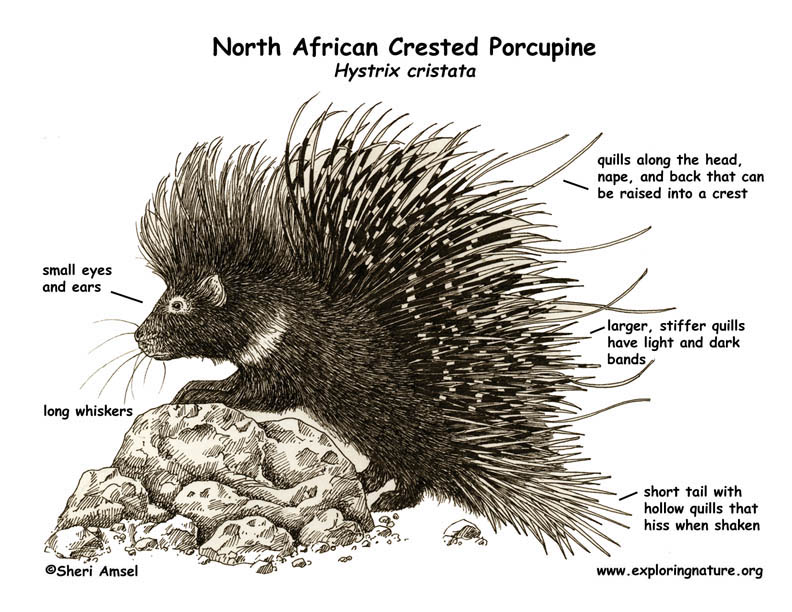

They are found in Africa and along the Mediterranean coast into Italy.
They live in many habitats from deserts to grasslands, forests and the rocky scrublands in between. Like North American porcupines, they favor habitats where they can shelter in rock clefts or caves, but they will also dig burrows.
They are about 3.5 feet (110 cm) long and can weigh more than 60 pounds (27 kg).
The whole body is covered with coarse, dark bristles. In addition, the back and the back of the head and neck are covered in long quills that can be raised into a crest. There are also many larger, stiffer quills along the sides and back half of the body that have light and dark bands. They have a short tail with hollow quills at the end that, when shaken, make a hissing sound. They have four-clawed toes in the front and five in the back. They walk flat-footed on padded soles like a bear. They have small eyes and ears and long whiskers.
They are active at night (nocturnal). They raise their quills if threatened and wave them in the air. They also shake their tail quills, which makes a humming sound and stamp their feet. If the predator does not back off, they will charge backward impaling them with stiff quills. This can cause serious injury or death. They live in small family groups, both parents caring for young.
They eat mostly plants, roots, tree bark, and fruits, but may feed on insects, spiders or even dead animals (carrion). They sometimes prove to be farm pests, eating crops.
They are killed by hyenas, hawks, eagles, lions, leopards and man.
Females are pregnant for 2-4 months (gestation) and have 1-2 young. At birth, the spines are soft and harden after about a week. Once the spines harden, kits begin to leave the nest and are eating solid food in less than a month.
They can live up to 20 years.
They are listed as endangered in Italy.
Kingdom: Animalia
Phylum: Chordata
Subphylum: Vertebrata
Class: Mammalia
Order: Rodentia
Suborder: Hystricomorpha
Family: Hystricidae
Genus: Hystrix
Species: H. cristata
When you research information you must cite the reference. Citing for websites is different from citing from books, magazines and periodicals. The style of citing shown here is from the MLA Style Citations (Modern Language Association).
When citing a WEBSITE the general format is as follows.
Author Last Name, First Name(s). "Title: Subtitle of Part of Web Page, if appropriate." Title: Subtitle: Section of Page if appropriate. Sponsoring/Publishing Agency, If Given. Additional significant descriptive information. Date of Electronic Publication or other Date, such as Last Updated. Day Month Year of access < URL >.
Amsel, Sheri. "Porcupine (North African Crested)" Exploring Nature Educational Resource ©2005-2024. December 13, 2024
< http://exploringnature.org/db/view/Porcupine-North-African-Crested >

